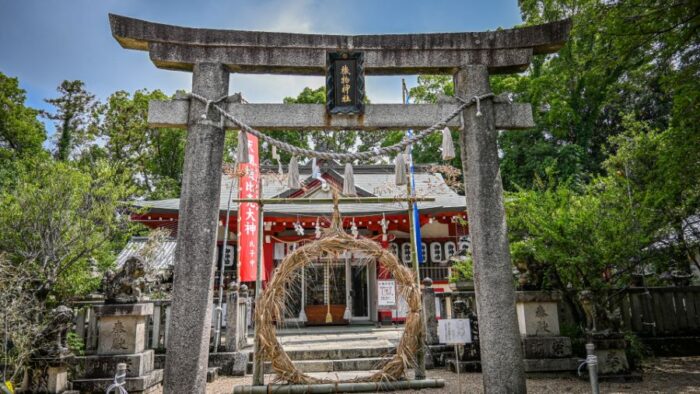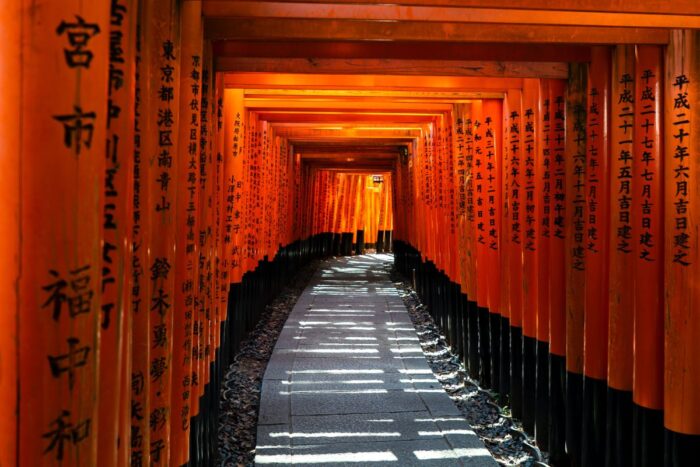Every year in June, Shinto shrines across Japan come alive with the sacred tradition of Nagoshi no Harae. This ancient ritual, established during the Nara Period, offers a chance for atonement and renewal.

Legend tells of the protective power of the chinowa wreath, worn by Somin Shorai and his descendants to ward off a devastating plague. With the chief priest leading the way, participants pass through the wreath, symbolizing purification and the shedding of misdeeds.
Join us as we delve into the rich history, cultural significance, and immersive experiences of Nagoshi no Harae, Japan’s great purification ritual.
Key Takeaways
- Nagoshi no Harae is an annual purification ritual in Japan that takes place in June at Shinto shrines.
- The ritual was established during the Nara Period and is a way to atone for sins committed in the first half of the year and start anew.
- The tradition originates from a legend involving Susanoo no Mikoto and Somin Shorai, where a chinowa wreath protected Somin and his descendants from a plague.
- The ritual involves participants passing through a chinowa wreath, symbolizing cleansing and getting rid of misdeeds, and offering prayers for health and protection.
Historical Background and Legend
During the Nara Period, the annual Nagoshi no Harae ritual was established as a means of atoning for sins committed in the first half of the year and offering a chance for a new beginning.
This sacred tradition has its origin story deeply rooted in Japanese folklore. Legend has it that a man named Somin Shorai showed great hospitality to the god Susanoo no Mikoto and received a chinowa wreath as a token of gratitude.
Wearing the wreath brought protection and good fortune to Somin and his descendants, warding off a devastating plague. This practice of wearing the chinowa wreath to protect against calamities has been passed down through generations.
Today, the Nagoshi no Harae ritual symbolizes purification and serves as a reminder of the importance of seeking spiritual well-being and a fresh start.
Ritual Dynamics and Locations
Participants in the annual ceremony pass through a sacred grass wreath called chinowa, symbolizing the cleansing and ridding of misdeeds. The ritual dynamics and locations of Nagoshi no Harae offer a unique and immersive experience for participants.
Here are four key aspects to consider:
- Infinity Path: Participants follow an infinity (∞) path through the chinowa wreath, representing the continuous cycle of purification and renewal.
- Chief Priest: The ceremony is led by a chief priest who guides and leads the participants through the ritual, ensuring its proper execution.
- Participating Shrines: Kitano Tenmangu Shrine, Kamigamo Shrine, and Yoshida Shrine are popular places to celebrate Nagoshi no Harae in Kyoto. Each shrine offers its own unique experiences and traditions.
- Cleansing Symbolism: The act of passing through the chinowa not only cleanses and rids participants of misdeeds but also offers prayers for health and protection.
Participating in Nagoshi no Harae at these shrines allows individuals to engage with the rich cultural traditions and experience the profound symbolism of purification and renewal.
Dates, Timing, and Cultural Significance
The annual ceremony of Nagoshi no Harae holds cultural significance in Japanese society. It provides an opportunity for self-reflection and renewal. This sacred tradition has been celebrated on June 30th every year since 710 AD. It offers individuals a chance to cleanse themselves of misdeeds and pray for health and protection.
Nagoshi no Harae is a midyear occasion that continues to be celebrated regardless of ongoing circumstances or conflicts. It showcases the importance of rituals in Japanese culture and promotes spiritual well-being.
During this ritual, participants pass through a sacred grass wreath called chinowa. The wreath symbolizes purification and protection. As part of the cultural immersion, traditional refreshments called minazuki are sold during this period. Minazuki are steamed cakes topped with azuki beans. The triangular shape of the cakes represents driving away malevolent spirits, further enhancing the significance of the celebration.
Importance and Symbolism
Symbolizing purification and protection, the sacred grass wreath used in Nagoshi no Harae is passed through by participants during the ritual, offering prayers for health and good fortune. Here are four reasons why the importance and symbolism of this tradition continue to resonate in modern society:
- Connection to spiritual well-being: Nagoshi no Harae promotes a sense of spiritual cleansing and renewal. It allows individuals to reflect on their actions and seek forgiveness for any misdeeds, fostering inner peace and harmony.
- Cultural integration: The ritual embodies the Japanese belief system and showcases the integration of ancient traditions into modern life. It serves as a reminder of the importance of maintaining cultural heritage and finding balance between tradition and progress.
- Protection and purification: The sacred grass wreath represents the purification of the body, mind, and spirit. Passing through the wreath symbolizes the cleansing of misdeeds and the removal of negative energies, offering protection and good fortune in return.
- Significance in modern society: Nagoshi no Harae holds cultural and historical significance in Japanese society. It serves as a reminder of the value of rituals and traditions in promoting spiritual well-being, and it continues to be celebrated annually, attracting visitors from all over the world.
Influence and Cultural Immersion
Deeply ingrained in the fabric of Japanese culture, Nagoshi no Harae continues to be celebrated annually and offers visitors from all over the world a unique opportunity to immerse themselves in the rich traditions and legends of Kyoto.
The influence and cultural immersion provided by this sacred tradition are unmatched. As visitors step into the shrines of Kyoto, they are transported back in time, where ancient rituals and customs come to life.
The celebration showcases the deep cultural significance of Nagoshi no Harae, allowing visitors to witness firsthand the importance of purification and protection in Japanese society. Engaging with the local community, visitors can explore the historical significance of the ritual and discover the unique blend of ancient and modern elements that define Japanese culture.
It is an experience that leaves a lasting impression and deepens one’s understanding of Japan’s traditions and beliefs.
Frequently Asked Questions
How long does the Nagoshi no Harae ritual typically last?
The Nagoshi no Harae ritual typically lasts for a few hours. Shinto priests play a crucial role in conducting the ceremony, leading participants through the sacred grass wreath and guiding them in prayers for health, protection, and purification.
Are there any specific rituals or actions that participants must perform while passing through the chinowa wreath?
Participants pass through the chinowa wreath during Nagoshi no Harae, symbolizing purification and protection. This ritual emphasizes the importance of purification in Japanese culture, promoting spiritual well-being and the removal of misdeeds.
What types of misdeeds or sins are typically addressed and cleansed during the Nagoshi no Harae ritual?
During the Nagoshi no Harae ritual, participants seek purification and forgiveness for various misdeeds or sins. This ancient tradition has evolved to hold cultural significance and adapt to modern life, promoting spiritual well-being and renewal.
Are there any specific prayers or chants that are recited during the ceremony?
During the Nagoshi no Harae ceremony, specific prayers and chants are recited by participants as they pass through the chinowa wreath. The prayers focus on health, protection, and the purification of misdeeds. The chinowa wreath symbolizes cleansing and the removal of impurities.
How has the Nagoshi no Harae ritual evolved or changed over the centuries since its establishment in the Nara Period?
Over the centuries, the Nagoshi no Harae ritual has evolved under the influence of cultural changes. It has adapted to modern society while preserving its core essence of purification and protection, reflecting the dynamic nature of Japanese traditions.
The Sum Up
To sum it up, Nagoshi no Harae is a sacred tradition deeply rooted in Japanese culture. It offers a chance for atonement and new beginnings. This great purification ritual holds immense cultural significance, with its historical background and legend.
The ritual dynamics and locations, such as Kitano Tenmangu Shrine, Kamigamo Shrine, and Yoshida Shrine, provide unique experiences for participants. These locations offer a glimpse into the rich history and spirituality of Japan.
With its symbolism of cleansing and protection, Nagoshi no Harae promotes spiritual well-being. It showcases the embodiment of the Japanese belief system and the importance of maintaining a pure and balanced state of being.
This ancient tradition continues to attract visitors from all over. It allows them to immerse themselves in the rich tapestry of Japanese traditions. Nagoshi no Harae is a testament to the enduring cultural heritage of Japan and the profound impact it has on those who participate in it.





